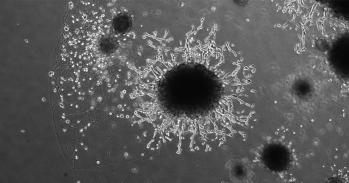In this video, we see a mouse embryo developing. Dr Erica Watson tells us that studying this process helps us better understand human pregnancy.
In this video, we see a mouse embryo developing. Dr Erica Watson tells us that studying this process helps us better understand human pregnancy.
We can get valuable information from a mouse model about how an embryo and its placenta develop over time.
Dr Erica Watson
Under the Microscope is a collection of videos that show glimpses of the natural and man-made world in stunning close-up. They will be released every Monday and Thursday for the next couple of months on the io9 website.
Dr Erica Watson:
"The development of a fetus is elegant yet complex. Amazingly, most fetuses undergo a highly orchestrated sequence of events during development to produce a healthy baby. This suggests that a baby can adapt to changes in the womb, such as to the availability of nutrients from its mother. But how do these environmental changes affect the baby's health in later life? And is it possible that these adverse changes will alter the development of generations to follow? In other words, does the environment that a baby develops in affect its grandchildren's growth and development?
Our research aims to understand these questions using a mouse model with a genetic mutation that prevents the normal breakdown folic acid (a vitamin). This mutation alters the metabolism of a mouse and causes long-lasting effects on the generations to come. Our hope is to find out how environmental changes caused by a genetic mutation are perpetuated into subsequent generations, even when these generations do not carry the mutation.
Since humans and mice use similar genes during development, we can get valuable information from a mouse model about how an embryo and its placenta develop over time. Compared to a human pregnancy that lasts nine months, a mouse fetus develops quickly, taking only three weeks to get from a one-cell embryo to a fully-grown mouse pup.
Using a light microscope, we generated this image showing the growth and development of a mouse embryo during the second week of pregnancy. The first embryo is nine days old and has few recognizable features whereas the last embryos is fourteen days old and more closely resembles a mouse pup as birth. Understanding the progression of normal developmental processes will ultimately help us explain the events that cause fetal development to go awry resulting in miscarriage or stillbirth."
The smallest fetus in the video is the thickness of a penny and the largest one is the size of a blueberry.
More information:
This work is licensed under a Creative Commons Licence. If you use this content on your site please link back to this page.





